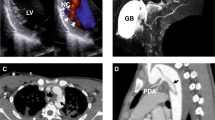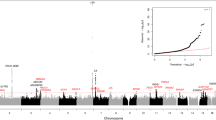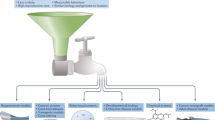Abstract
Conventional drug discovery approaches require a priori selection of an appropriate molecular target, but it is often not obvious which biological pathways must be targeted to reverse a disease phenotype1,2. Phenotype-based screens offer the potential to identify pathways and potential therapies that influence disease processes. The zebrafish mutation gridlock (grl, affecting the gene hey2) disrupts aortic blood flow in a region and physiological manner akin to aortic coarctation in humans3,4,5. Here we use a whole-organism, phenotype-based, small-molecule screen to discover a class of compounds that suppress the coarctation phenotype and permit survival to adulthood. These compounds function during the specification and migration of angioblasts. They act to upregulate expression of vascular endothelial growth factor (VEGF), and the activation of the VEGF pathway is sufficient to suppress the gridlock phenotype. Thus, organism-based screens allow the discovery of small molecules that ameliorate complex dysmorphic syndromes even without targeting the affected gene directly.
This is a preview of subscription content, access via your institution
Access options
Subscribe to this journal
Receive 12 print issues and online access
$209.00 per year
only $17.42 per issue
Buy this article
- Purchase on Springer Link
- Instant access to full article PDF
Prices may be subject to local taxes which are calculated during checkout




Similar content being viewed by others
References
Crews, C.M. & Splittgerber, U. Chemical genetics: exploring and controlling cellular processes with chemical probes. Trends Biochem. Sci. 24, 317–320 (1999).
Schreiber, S.L. Target-oriented and diversity-oriented organic synthesis in drug discovery. Science 287, 1964–1969 (2000).
Zhong, T.P., Rosenberg, M., Mohideen, M.A., Weinstein, B. & Fishman, M.C. gridlock, an HLH gene required for assembly of the aorta in zebrafish. Science 287, 1820–1824 (2000).
Weinstein, B.M., Stemple, D.L., Driever, W. & Fishman, M.C. Gridlock, a localized heritable vascular patterning defect in the zebrafish. Nat. Med. 1, 1143–1147 (1995).
Towbin, J.A. & McQuinn, T.C. Gridlock; a model for coarctation of the aorta? Nat. Med. 1, 1141–1142 (1995).
St. Johnston, D. The art and design of genetic screens: Drosophila melanogaster. Nat. Rev. Genet. 3, 176–188 (2002).
Sakata, Y. et al. Ventricular septal defect and cardiomyopathy in mice lacking the transcription factor CHF1/Hey2. Proc. Natl. Acad. Sci. USA 99, 16197–16202 (2002).
Donovan, J., Kordylewska, A., Jan, Y.N. & Utset, M.F. Tetralogy of fallot and other congenital heart defects in hey2 mutant mice. Curr. Biol. 12, 1605–1610 (2002).
Gessler, M. et al. Mouse gridlock: no aortic coarctation or deficiency, but fatal cardiac defects in hey2−/− mice. Curr. Biol. 183, 37–48 (1997).
Eriksson, J. & Lofberg, J. Development of the hypochord and dorsal aorta in the zebrafish embryo (Danio rerio). J. Morphol. 244, 167–176 (2000).
Fouquet, B., Weinstein, B.M., Serluca, F.C. & Fishman, M.C. Vessel patterning in the embryo of the zebrafish: guidance by notochord. Dev. Biol. 183, 37–48 (1997).
Cleaver, O. & Krieg, P.A. VEGF mediates angioblast migration during development of the dorsal aorta in Xenopus. Development 125, 3905–3914 (1998).
Carmeliet, P. et al. Abnormal blood vessel development and lethality in embryos lacking a single VEGF allele. Nature 380, 435–439 (1996).
Ferrara, N. et al. Heterozygous embryonic lethality induced by targeted inactivation of the VEGF gene. Nature 380, 439–442 (1996).
Stalmans, I. et al. VEGF: a modifier of the del22q11 (DiGeorge) syndrome? Nat. Med. 9, 173–182 (2003).
Liang, D. et al. The role of vascular endothelial growth factor (VEGF) in vasculogenesis, angiogenesis, and hematopoiesis in zebrafish development. Mech. Dev. 108, 29–43 (2001).
Zhong, T.P., Childs, S., Leu, J.P. & Fishman, M.C. Gridlock signaling pathway fashions the first embryonic artery. Nature 414, 216–220 (2001).
Iso, T., Chung, G., Hamamori, Y. & Kedes, L. HERP1 is a cell type-specific primary target of Notch. J. Biol. Chem. 277, 6598–6607 (2002).
Nakagawa, O. et al. Members of the HRT family of basic helix-loop-helix proteins act as transcriptional repressors downstream of Notch signaling. Proc. Natl. Acad. Sci. USA 97, 13655–13660 (2000).
Lawson, N.D., Vogel, A.M. & Weinstein, B.M. Sonic hedgehog and vascular endothelial growth factor act upstream of the Notch pathway during arterial endothelial differentiation. Dev. Cell 3, 127–136 (2002).
Ash, J.D. & Overbeek, P.A. Lens-specific VEGF-A expression induces angioblast migration and proliferation and stimulates angiogenic remodeling. Dev. Biol. 223, 383–398 (2000).
Shin, J.T. & Fishman, M.C. From Zebrafish to human: modular medical models. Annu. Rev. Genomics Hum. Genet. 3, 311–340 (2002).
Dooley, K. & Zon, L.I. Zebrafish: a model system for the study of human disease. Curr. Opin. Genet. Dev. 10, 252–256 (2000).
Xu, X. et al. Cardiomyopathy in zebrafish due to mutation in an alternatively spliced exon of titin. Nat. Genet. 30, 205–209 (2002).
Roman, B.L. et al. Disruption of acvrl1 increases endothelial cell number in zebrafish cranial vessels. Development 129, 3009–3019 (2002).
Langheinrich, U. Zebrafish: a new model on the pharmaceutical catwalk. Bioessays 25, 904–912 (2003).
Milan, D.J., Peterson, T.A., Ruskin, J.N., Peterson, R.T. & MacRae, C.A. Drugs that induce repolarization abnormalities cause bradycardia in zebrafish. Circulation 107, 1355–1358 (2003).
Thomas, C.E., Ehrhardt, A. & Kay, M.A. Progress and problems with the use of viral vectors for gene therapy. Nat. Rev. Genet. 4, 346–358 (2003).
Check, E. Cancer risk prompts US to curb gene therapy. Nature 422, 7 (2003).
Wienholds, E., Schulte-Merker, S., Walderich, B. & Plasterk, R.H. Target-selected inactivation of the zebrafish rag1 gene. Science 297, 99–102 (2002).
Acknowledgements
This work was supported by grants from the National Institutes of Health, by the Ned Sahin Research Fund for Restoring Developmental Plasticity and by a sponsored research agreement with Novartis Institutes for Biomedical Research. S.Y.S. is a Physician-Postdoctoral Fellow and S.L.S. is an Investigator at the Howard Hughes Medical Institute. S.L.S. is also supported by a grant from the Donald W. Reynolds Cardiovascular Clinical Research Center (University of Texas Southwestern Medical Center).
Author information
Authors and Affiliations
Corresponding author
Ethics declarations
Competing interests
R.T.P. and C.A.M. receive research funding through a sponsored research agreement with Novartis Institutes for BioMedical Research.
Rights and permissions
About this article
Cite this article
Peterson, R., Shaw, S., Peterson, T. et al. Chemical suppression of a genetic mutation in a zebrafish model of aortic coarctation. Nat Biotechnol 22, 595–599 (2004). https://doi.org/10.1038/nbt963
Received:
Accepted:
Published:
Issue Date:
DOI: https://doi.org/10.1038/nbt963
This article is cited by
-
Zebrafish disease models in drug discovery: from preclinical modelling to clinical trials
Nature Reviews Drug Discovery (2021)
-
One-step generation of zebrafish carrying a conditional knockout-knockin visible switch via CRISPR/Cas9-mediated intron targeting
Science China Life Sciences (2020)
-
Synergistic interaction of sprouting and intussusceptive angiogenesis during zebrafish caudal vein plexus development
Scientific Reports (2018)
-
Zebrafish: an emerging real-time model system to study Alzheimer’s disease and neurospecific drug discovery
Cell Death Discovery (2018)
-
VEGF/PKD-1 signaling mediates arteriogenic gene expression and angiogenic responses in reversible human microvascular endothelial cells with extended lifespan
Molecular and Cellular Biochemistry (2018)



